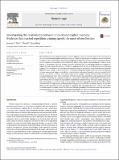Files in this item
Investigating the relationship between implicit and explicit memory : evidence that masked repetition priming speeds the onset of recollection
Item metadata
| dc.contributor.author | Park, Joanne L. | |
| dc.contributor.author | Donaldson, David I. | |
| dc.date.accessioned | 2019-11-07T13:30:05Z | |
| dc.date.available | 2019-11-07T13:30:05Z | |
| dc.date.issued | 2016-10-01 | |
| dc.identifier | 262819815 | |
| dc.identifier | c82cdd31-d386-429c-8009-1ba44768c090 | |
| dc.identifier | 84974809027 | |
| dc.identifier | 27291494 | |
| dc.identifier.citation | Park , J L & Donaldson , D I 2016 , ' Investigating the relationship between implicit and explicit memory : evidence that masked repetition priming speeds the onset of recollection ' , NeuroImage , vol. 139 , pp. 8-16 . https://doi.org/10.1016/j.neuroimage.2016.06.013 | en |
| dc.identifier.issn | 1053-8119 | |
| dc.identifier.other | ORCID: /0000-0002-8036-3455/work/67526223 | |
| dc.identifier.uri | https://hdl.handle.net/10023/18879 | |
| dc.description | J.L.P. was funded by the Economic and Social Research Council (www.esrc.ac.uk) through award reference ES/I901078/1. J.L.P. and D.I.D. are members of the SINAPSE collaboration (www.sinapse.ac.uk), a pooling initiative funded by the Scottish Funding Council and the Chief Scientific Office of the Scottish Executive. | en |
| dc.description.abstract | Memory theories assume that unconscious processes influence conscious remembering, but the exact nature of the relationship between implicit and explicit memory remains an open question. Within the context of episodic recognition tests research typical shows that priming impacts behavioral and neural indices of familiarity. By this account, implicit memory leads to enhanced fluency of processing, which is then attributed to 'oldness' in the context of recognition judgments. Recently, however, behavioral and neuroimaging evidence has emerged to suggest that priming can also influence recollection, suggesting that the rate of recollection increases following priming. Here, we examine the relationship between priming and recollection, using Event-Related Potentials (ERPs) to assess changes in the timecourse of processing. Participants studied a series of words, and episodic memory was assessed using a standard item recognition test, but masked repetition priming preceded half of the test cues. Results confirmed that implicit memory was engaged: priming produced robust facilitation of recognition Reaction Times (RTs), with larger effects for studied than unstudied words. Mapping onto the RT data, ERPs recorded during recognition testing over centro-parietal electrodes revealed N400-like priming effects (250-500 ms) that were larger in magnitude for studied than unstudied words. More importantly, priming also had a clear impact on explicit memory, as measured by recollection-related left-parietal old/new effects. While old/new effects for unprimed trials were present during the typical 500-800 ms latency interval, the old/new effects seen for primed trials were equivalent in magnitude and topography, but onset ~. 300 ms earlier. ERPs reveal that repetition priming speeds the onset of recollection, providing a novel demonstration that unconscious memory processes can have a measureable, functional, influence on conscious remembering. | |
| dc.format.extent | 9 | |
| dc.format.extent | 707439 | |
| dc.language.iso | eng | |
| dc.relation.ispartof | NeuroImage | en |
| dc.subject | Episodic memory | en |
| dc.subject | Event-Related Potentials (ERPs) | en |
| dc.subject | Masked repetition priming | en |
| dc.subject | N400 | en |
| dc.subject | Recollection | en |
| dc.subject | RC0321 Neuroscience. Biological psychiatry. Neuropsychiatry | en |
| dc.subject | Neurology | en |
| dc.subject | Cognitive Neuroscience | en |
| dc.subject | NDAS | en |
| dc.subject.lcc | RC0321 | en |
| dc.title | Investigating the relationship between implicit and explicit memory : evidence that masked repetition priming speeds the onset of recollection | en |
| dc.type | Journal article | en |
| dc.contributor.institution | University of St Andrews. School of Psychology and Neuroscience | en |
| dc.identifier.doi | 10.1016/j.neuroimage.2016.06.013 | |
| dc.description.status | Peer reviewed | en |
This item appears in the following Collection(s)
Items in the St Andrews Research Repository are protected by copyright, with all rights reserved, unless otherwise indicated.

